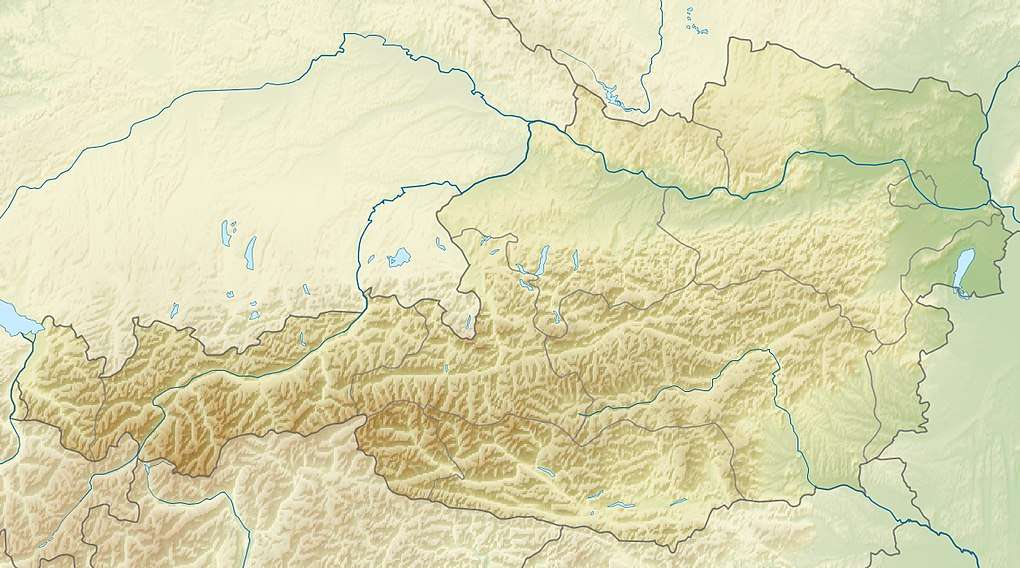Lasörling
The Lasörling is a mountain, 3,098 m (AA), and the highest summit in the eponymous range that stretches from the Virgental to the Defereggental valleys opposite the Großvenediger. Occasionally the mountain is also called the "Großer Lasörling" ("Great Lasörling) because it has a double summit - its southeast top reaching a height of 3,055 m above sea level (AA). The main top was formerly also called the Bergerspitze, and the southeast top the Musspitze or Virgen Lasörling.[1]
| Lasörling | |
|---|---|
The Lasörling from the Vorderer Sajatkopf | |
| Highest point | |
| Elevation | 3,098 m (AA) (10,164 ft) |
| Prominence | 490 m ↓ Bachlenke |
| Isolation | 7.39 km → Alplesspitze |
| Coordinates | 46°58′00″N 12°21′00″E |
| Geography | |
 Lasörling | |
| Parent range | Venediger Group |
| Climbing | |
| Normal route | Southern ascent from the Glauret (I) |
The easiest ascent of the mountain begins in the valley of Virgental and runs through the Mullitztal valley to the Lasörling Hut. This climb is glacier-free, but requires sure-footedness and has climbing sections rated at grade I.
Name
The name "Lasörling" refers to the appearance of the mountain: Arl(ing) is an old German word for ploughshare or plough and stems from the Old Germanic word[2] or loanword from the Slovene word oralnik.[3] Around 1531, the mountain was still recorded with the Slovenian suffix -nik as "Lasornik".[3] For the year 1670 it is written as "Lasernik".[4] The syllable -nik was replaced in later usage by "-ling".[3] The prefix "Las-" goes back to the (Old) Slovenian word for clearance (German: Gereute), as in other words like Lasnitzen, Laßnitz etc.[5][6]
First ascent
The Lasörling was first climbed via the northern arête in 1861 by Carl von Sonklar after several attempts.[7]
According to other sources[1] the first climbers are unknown, but probably hunters. The first historically confirmed ascent was carried out by H. v. Acken and his survey assistants in 1854 in the course of state survey work using the present normal route, the southern ascent from the Glauret. Carl Sonklar first crossed the east face on the descent (1861) and the northwestern arête (1864).
Routes to the summit
The most popular route up the Lasörling runs initially from the Lasörling Hut (2,350 m above sea level (AA)) heading northwest into the former mining area of Glauret. South of the summit the path branches off north and runs in zig-zags over piles of moraine to the Lasörlingscharte notch (2,950 m above sea level (AA)) and finally to the summit. The 748 metres of height can be climbed in about three hours.[8]
The shortest way from the Virgental valley to the summit runs through the Lasnitzental valley in a southern and later southeasterly direction to the western arête. After a short and easy climb on the ridge in an easterly direction the route arrives at the Lasörlingscharte and joins the path from the Lasörling Hut.
Literature
- Richard Goedeke: 3000er in den Nordalpen. Bruckmann, München 2004, ISBN 3-7654-3930-4
- Walter Mair: Osttiroler Wanderbuch. Tyrolia, Innsbruck 2001, 6. Auflage
- Hubert Peterka / Willi End: Alpenvereinsführer Venedigergruppe. Bergverlag Rudolf Rother, Munich, 1982, ISBN 3-7633-1242-0.
References
- Peterka/End 1982, Randzahl 1381
- Arl. In: Jacob and William Grimm: Deutsches Wörterbuch. Vol. 1 A–Biermolke. Leipzig, 1854. Keyword column 551 line 56. Reprint by the Deutscher Taschenbuch Verlag, Munich, 1991, ISBN 3-423-05945-1. dtv 5945. Cited from Der digitale Grimm – Elektronische Ausgabe der Erstbearbeitung. Version 12/04, 2001, Frankfurt am Main, ISBN 3-86150-628-9. Kompetenzzentrum für elektronische Erschließungs- und Publikationsverfahren in den Geisteswissenschaften an der Universität Trier in Verbindung mit der Berlin-Brandenburgischen Akademie der Wissenschaften. See there also the article on the keyword "Pflug": Vol. 13 N–Quurren. Leipzig, 1889. column 1773, line 45.
- Wilhelm Brandenstein: Zur Ortsnamenforschung in Osttirol. In: Osttiroler Heimatblätter. No. 10 (1930), Issue 11/12, pages 90–93. Cited from: Fritz Freiherr Lochner von Hüttenbach: Wilhelm Brandenstein. Kleine namenkundliche Arbeiten. Akademische Druck- und Verlagsanstalt. Graz, 1978, ISBN 3-201-01038-3, pages 89–96. Zum Namen Lasörling: page 96.
- Otto Stolz: Politisch-historische Landesbeschreibung Part 1 Nordtirol. Vienna & Leipzig, 1923. p. 607. Cited from: Monika Voggenberger. Die slawischen Ortsnamen in Osttirol. Keyword: "Lasörling".
- Manfred Trummer: Slawische Steiermark = Slightly expanded edition of the eponymous presentation at the symposium "Fremd sein – beinander bleiben. Die slowenische Volksgruppe in Österreich" as part of the "Slovenian Days" at the Karl Franzens University in Graz, 25–28 March 1996. from Christian Stenner (ed.): Slowenische Steiermark. Verdrängte Minderheit in Österreichs Südosten. Zur Kunde Südosteuropas II/23 series published by the Institute for History of the University of Graz, Department of Southeast European History, Univ. Prof. Dr. Karl Kaser. Böhlau, Vienna / Cologne / Weimar, 1997, ISBN 3-205-98690-3, pages 15–34 (examples: pages 21, 22 and 24).
- Lasnitzen. In: Monika Voggenberger. Die slawischen Ortsnamen in Osttirol. Salzburg, 1983. Doctorate dissertation at the Liberal Arts Faculty of the University of Salzburg.
- Walter Mair: Osttiroler Wanderbuch, p. 260
- Walter Mair: Osttiroler Wanderbuch, p. 259 f.
